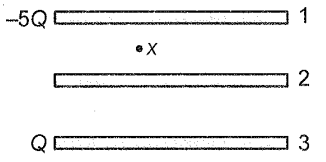Electric field at an axial point of short dipole is . If the electric field at the equatorial point of same dipole is , then which of the following is correct?
1. . < 0
2. . > 0
3. . = 0
4. . =
A long thin rod is charged such that charge per unit length of the rod is . The rod is inserted into a hollow spherical surface of radius R. Maximum electric flux coming out the surface is
1.
2.
3.
4.
Two charges q and 4q are separated by a distance r. The neutral point(in between the line joining the charges) is at a distance:
1.
2.
3.
4.
A positron and a proton are projected normally into a uniform electric field with equal kinetic energy. The trajectory followed by them are
1. Circular with equal radius
2. Elliptical with the same major and minor axis
3. Parabolic with the identical trajectory
4. Hyperbolic with the identical trajectory
The distance between two point charges is increased by 10%. The force of interaction
1. Increases by 10%
2. Decreases by 10%
3. Decreases by 17%
4. Increases by 17%
Cm is the SI unit of
1. Electric flux
2. Electric potential
3. Electric dipole moment
4. Electric field intensity
A solid sphere of radius R has a uniform distribution of electric charge in its volume. At a distance x from its center (x<R), the electric field is directly proportional to
1.
2.
3. x
4.
An insulated sphere of radius R has a uniform charge density . The electric field at a distance r from the center of the sphere (r<R) is-
1.
2.
3.
4.
The electric flux from a cube of edge \(l\) is \(\phi\). What will be its value if the edge of the cube is made \(2l\) and the charge enclosed is halved?
1. \(\frac{1}{2}\phi\)
2. \(2\phi\)
3. \(4\phi\)
4. \(\phi\)
Three identical plates are kept as shown. Plate 1 is given -5Q charge and plate 3 is given Q charge. Electric field intensity at point x is

1.
2.
3.
4.






